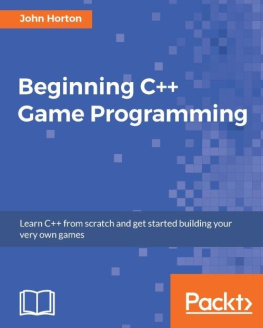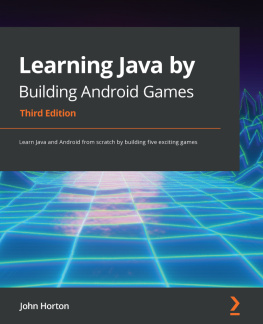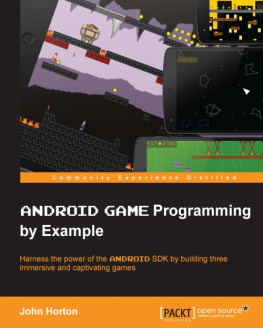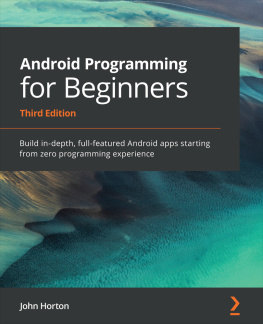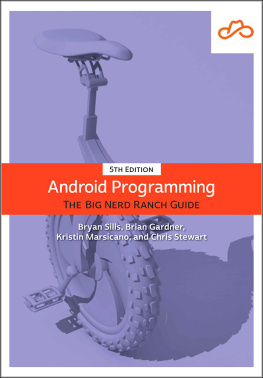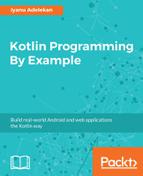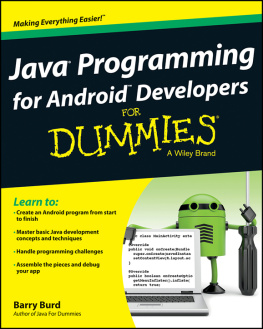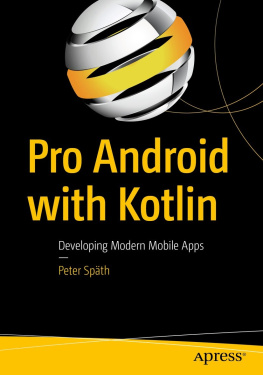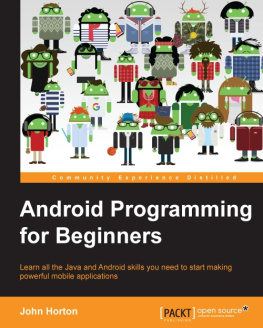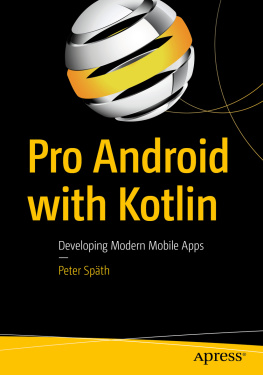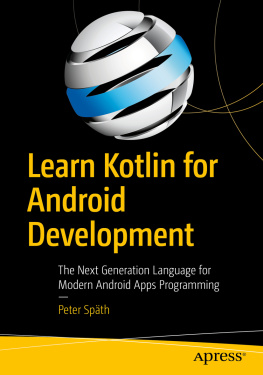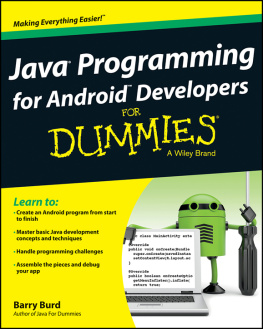What this book covers
, Getting Started with Android and Kotlin , welcomes you to the exciting world of Android and Kotlin . In this first chapter, we won't waste any time before getting started developing Android apps. We will look at what is so great about Android, what Android and Kotlin are, how they work and complement each other, and what that means to us as future developers. Moving on, we will set up the required software so that we can build and deploy a simple first app.
, Kotlin, XML, and the UI Designer , discusses how, at this stage, we have a working Android development environment and we have built and deployed our first app. It is obvious, however, that code autogenerated by Android Studio is not going to make the next top-selling app on Google Play. We need to explore this autogenerated code so that we can begin to understand Android and then learn how to build on this useful template.
, Exploring Android Studio and the Project Structure , takes us through creating and running two more Android projects. The purpose of these exercises is to explore Android Studio and the structure of Android projects more deeply. When we build our apps ready for deployment, the code and the resource files need to be packed away in the APK file just as they are. Therefore, all the layout files and other resources, which we will be looking at soon, need to be in the correct structures. Fortunately, Android Studio handles this for us when we create a project from a template. However, we still need to know how to find and amend these files, how to add our own and sometimes remove the files created by Android Studio, and how the resource files are interlinked sometimes with each other and sometimes with the Kotlin code (that is, the autogenerated Kotlin code as well as our own). Along with understanding the composition of our projects, it will also be beneficial to make sure that we get the most from the emulator.
, Getting Started with Layouts and Material Design , builds on what we have already seen; that is, the Android Studio UI designer and a little bit more Kotlin in action. In this hands-on chapter, we will build three more layouts still quite simple, yet a step up from what we have done so far. Before we get to the hands-on part, we will have a quick introduction to the concept of material design . We will look at another type of layout called LinearLayout and walk through it, using it to create a usable UI. We will take things a step further using ConstraintLayout both to understand constraints and design more complex and precise UI designs. Finally, we will use TableLayout to lay data out in an easily readable table. We will also write some Kotlin code to switch between our different layouts within one app/project. This is the first major app that links together multiple topics into one neat parcel. The app is called Exploring Layouts .
, Beautiful Layouts with CardView and ScrollView , is the last chapter on layouts before we spend some time focusing on Kotlin and object-oriented programming. We will formalize our learning on some of the different attributes we have already seen, and we will also introduce two more cool layouts, ScrollView and CardView. To finish the chapter off, we will run the CardView project on a tablet emulator.
, The Android Lifecycle , will familiarize us with the lifecycle of an Android app. The idea that a computer program has a lifecycle might sound strange at first, but it will soon make sense. The lifecycle is the way that all Android apps interact with the Android OS. In the same way that the lifecycle of humans enables them to interact with the world around them, we have no choice but to interact with the Android lifecycle, and we must be prepared to handle numerous unpredictable events if we want our apps to survive. We will explore the phases of the lifecycle that an app goes through, from creation to destruction, and how this helps us know where to put our Kotlin code, depending on what we are trying to achieve.
, Kotlin Variables, Operators, and Expressions , along with the following chapter, explains the core fundamentals of Kotlin. In fact, we will explore the topics that are the main principles of programming in general. In this chapter, we will focus on the creation and understanding of the data itself, and in the next chapter, we will explore how to manipulate and respond to it.
, Kotlin Decisions and Loops , moves on from variables, and we now understand how to change the values that they hold with expressions, but how can we take a course of action that is dependent upon the value of a variable? We can certainly add the number of new messages to the number of previously unread messages, but how can we, for example, trigger an action within our app when the user has read all their messages? The first problem is that we need a way to test the value of a variable, and then respond when the value falls within a range of values or is equal to a specific value. Another problem that is common in programming is that we need sections of our code to be executed a certain number of times (more than once, or sometimes not at all) depending on the value of variables. To solve the first problem, we will look at making decisions in Kotlin with if, else, and when. To solve the latter, we will look at loops in Kotlin with while, dowhile, for, continue, and break. Furthermore, we will learn that, in Kotlin, decisions are also expressions that produce a value.
, Kotlin Functions , explains that functions are the building blocks of our apps. We write functions that do specific tasks, and then call them when we need to execute that specific task. As the tasks we need to perform in our apps will be quite varied, our functions need to cater to this and be very flexible. Kotlin functions are very flexible, more so than the functions of other Android-related languages. We therefore need to spend a whole chapter learning about them. Functions are intimately related to object-oriented programming, and once we understand the basics of functions, we will be in a good position to take on the wider learning of object-oriented programming.
, Object-Oriented Programming , explains that, in Kotlin, classes are fundamental to just about everything and, in fact, just about everything is a class. We have already talked about reusing other people's code, specifically the Android API, but in this chapter, we will really get to grips with how this works and learn about object-oriented programming (OOP) and how to use it.
, Inheritance in Kotlin , shows inheritance in action. In fact, we have already seen it, but now we will examine it more closely, discuss the benefits, and write classes that we inherit from. Throughout the chapter, I will show you several practical examples of inheritance, and at the end of the chapter we will improve our naval battle simulation from the previous chapter and show how we could have saved lots of typing and future debugging by using inheritance.
, Connecting Our Kotlin to the UI and Nullability , fully reveals, by the end of the chapter, the missing link between our Kotlin code and our XML layouts, leaving us with the power to add all kinds of widgets and UI features to our layouts as we have done before, but this time we will be able to control them through our code. In this chapter, we will take control of some simple UI elements, such as


